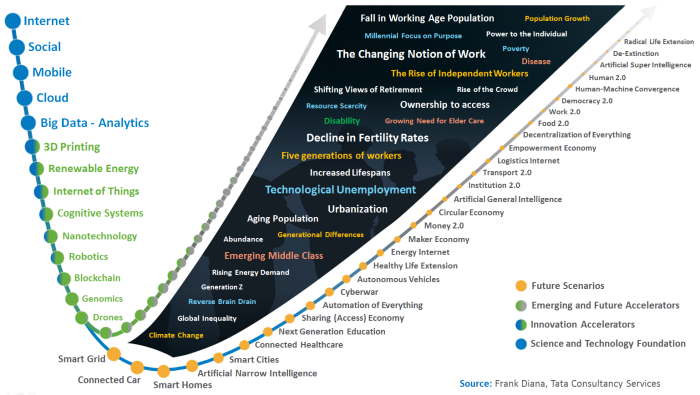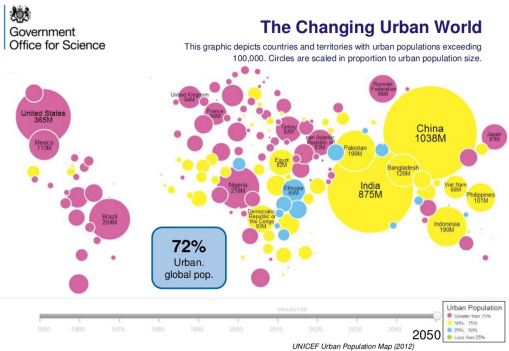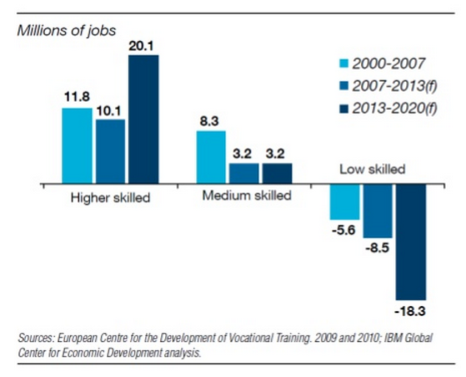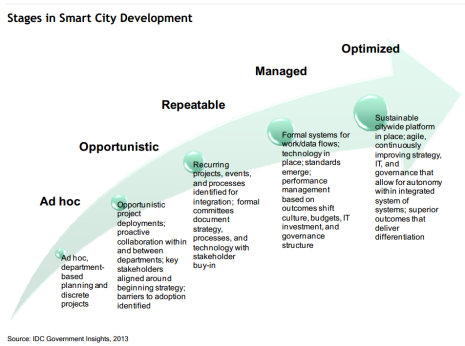Next up in this ongoing look at disruptive scenarios is the Smart City. For the first time in history, more than 50% of the world’s population lives in cities, and that percentage moves to 70% by 2050. This visual effectively captures the dramatic move towards urbanization:
In addition to rapid urbanization, the global population of people over 60 will double by 2050, putting additional stress on supporting the vulnerable. These two trends will amplify the challenges of an already challenged urban environment. Some of the existing challenges include: traffic congestion, dwindling resources, aging infrastructure, increasing global competition for talent, increasing demands on new and existing services, safety and security concerns, greenhouse gases, and limited parking to name a few. These challenges promise to intensify with urban growth, and they are already severe in several key areas. For example, according to a smart parking company called Streetline, experts estimate that 30 percent of urban traffic and associated vehicle emissions are directly related to motorists looking for parking. They quote a year-long study that found drivers in a 15-block district of Los Angeles drove in excess of 950 miles while searching for parking, producing 730 tons of carbon dioxide and using 47,000 gallons of gas. The International Energy Agency (IEA) estimates that urban areas contribute over 67% of global greenhouse gases, rising to 74% by 2030.
Another key challenge that intensifies over time is the fight for talent. Cities are increasingly challenged to keep pace with the education and workforce reskilling requirements of the future. A next generation of education must emerge to address the increasing need for highly skilled workers and the implications to jobs affected by advances in automation. This simple chart makes the job implications fairly clear:
Growing urban challenges increase the focus on the Smart City agenda, as city leaders face compelling reasons to act. Working with limited budgets, cities must find effective ways to address them through innovation and technology, with a strong focus on human, intellectual, and social capital. According to a recent study, the number of smart cities across the world is set to quadruple between 2013 and 2025, with many new city developments. India, for example, is planning to spend $1.13 billion on 100 of them. Cisco believes the global Smart City market is worth $3 trillion, with close to $6 billion coming from India in the next five years. While India is expected to drive future growth, the current leaders are Europe, Singapore, and Korea, with a greater level of activity expected in countries like Brazil and China. The Smart City market is therefore set to explode, with Frost & Sullivan projecting a $1.5 Trillion global market by 2020 across several different segments:
Smart City Benefits
The Internet of Things brings information-gathering to a completely new level, enabling city planners to understand their city like never before. This great example is provided in a recent IDC White paper:
“An interesting example is the use of acoustic sensors that are calibrated to detect gunshots. Some cities in the United States have deployed these sensors in areas of gun violence and discovered some shocking information. Police departments had historically assumed that residents called the police 80% of the time when shots were heard. And thus the police thought they had a fairly accurate measure of street gun violence. In San Francisco, after the sensors were in place, the police discovered that residents called the police only 10% of the time when shots were heard. In Oakland, California, the 911 call rate for shots fired was only 22%. Prior to the sensors, these police departments were operating on highly inaccurate information about the level of gun violence in certain neighborhoods. With this new information, police can now plan their patrols differently and better target areas to reduce gun violence.
With this unprecedented access to information, Smart Cities will deliver new levels of efficiency, effectiveness, safety, reliability, and higher levels of service. This access enables a city to anticipate and prevent problems in areas like reducing accidents by rerouting traffic, and reducing crime by identifying hot spots. New insight also enables the provision of services like finding a parking spot, monitoring air pollution, intelligent lighting, and others. A sense and respond model (a key future enabler) allows for the delivery of many of these services without human intervention.
A next generation of efficiency is also enabled, as asset tracking will streamline operations and insight will deliver unprecedented levels of efficiency. For example, a recent survey of water utilities found a saving potential between $7.1 and $12.5 billion each year through smart water solutions. The chief globalization officer of Cisco has said that smart cities drive energy consumption savings of 30% and water consumption savings of 50%. These environmental benefits include reducing greenhouse gas emissions and improving waste management. Boston University Installed self-powered trash receptacles which wirelessly alerted collection vehicles when they were full, resulting in on-campus trash collection being reduced from 14 times per week to an average of 1.6 times per week.
The Smart City
The Smart City is Defined as a developed urban area that creates sustainable economic development and a high quality of life by excelling in multiple key areas; economy, mobility, environment, people, living, and government. Excelling in these key areas requires strong human capital, social capital, and information and communications technology. We are in the early days of an evolution towards Smart Cities, and IDC Government Insights finds that most cities are deploying these projects department by department. In a recent IDC White paper, they provide a maturity model to describe this Smart City evolution:
In these early days, network infrastructure is a foundational Smart City investment, and increasingly, city services like finding a cab or bus, finding a nearby restaurant, reporting a problem, applying for a driver’s license, or tweeting to a government representative, must be available in the citizen’s pocket. Much like the challenges of the private sector, these new services must be delivered through new channels, while maintaining traditional ones. Some of the components of a Smart City are:
Smart City Ecosystem
The Smart City ecosystem may ultimately be the biggest and most complex ecosystem. As described in previous posts, Combinatorial Innovation accelerates the potential for new disruptive scenarios while enabling their realization. In the Smart City context, disruptive scenarios themselves must come together to enable the Smart city vision, making it an aggressive combination of innovation. The visual below is an expansion of the visual that I’ve used as the anchor for this disruptive scenario series, and describes the combinatorial nature of the smart City:
The primary digital forces form the Smart City foundation, which then combine with innovation accelerators like Renewable Energy, Robotics, and others. This technology foundation then combines with the highlighted disruptive scenarios to deliver against the smart city vision. Each of these disruptive scenarios brings a complicated ecosystem of its own, and when combined, forms a mega-ecosystem that amplifies the complexity. Consider the possible combinations of public and private sector stakeholders that have to come together to realize the ultimate vision: participants in complementary ecosystems, communication vendors, energy suppliers, building companies, health providers, education bodies, city planners and developers, system integrators, software vendors, the automotive industry, facility control providers, and technology providers for mobile technology, cloud computing, networking, Machine-to-Machine (M2M), Radio-Frequency Identification (RFID), and more.
Another way to look at the magnitude of the Smart City ecosystem would be from a data perspective. Look at the difference in the amount of resulting data across several key disruptive scenarios:
Source: Bosch
The ecosystem will expand organically, as cities open their data to the public to spur the creation of new businesses, exciting new jobs, and innovative services through applications that use this data.
Disruption
Demographic shifts and rapid urbanization are highly disruptive to cities – but the disruption does not end there. Smart City initiatives that leverage other disruptive scenarios have a multiplicative effect on disruption. For example, parking is an industry ripe for innovation, and smart parking solutions are emerging to manage the challenges referenced earlier. So in the short term, the industry should move to a more efficient place, as traffic congestion and vehicle emissions are reduced. But in the long term, what role does parking serve? The Autonomous Vehicle (another disruptive scenario) ultimately plays a major role in the future smart city, and it could make parking an unneeded component of the smart city landscape. In this case, the combination of disruptive scenarios completely disrupts the parking industry.
Competitive threats expand across a wide spectrum, as new opportunities arise for traditional companies to enter non-traditional ecosystems, and innovators to encroach on traditional company turf. In a Smart City context, energy and construction could be attractive spaces for the likes of Google, Cisco and other technology companies. Could a construction company acquisition be in their future – or do they become facilitators of a Smart City ecosystem that includes energy and construction companies? This recent LinkedIn post on Smart Cities and the Construction Industry provides additional insight. This is one small example of the cross-industry impacts likely to emerge, and more evidence of a shift from a vertical to horizontal orientation. Another cross-industry impact can be seen in this piece describing Comcast’s Worst Nightmare. Utility providers will likely compete with Telecom providers, as witnessed by EPB, a Chattanooga Tennessee public utility that realized smart-grid energy infrastructure could also provide consumers super-fast Internet speeds at competitive prices. The result is a system that now provides the nation’s fastest broadband speeds at prices often cheaper than the private competition.
Response
As with each scenario analyzed, every possible disruption requires a response. The Smart City scenario is very intriguing, and is likely to stimulate innovation on a large scale. It is driven by serious social challenges that must be addressed. As such, the public and private sector will come together to evolve the future of our cities. What’s so intriguing about this scenario is its broad reach. The mega-ecosystem that I referenced earlier speaks to the wide reaching disruptive implications of the Smart City agenda. In responding, governments and companies will continue to blur traditional boundaries. The private sector will see new competitors arise from places they never expected, but at the same time, new revenue streams will emerge as they leverage assets in new ways. The Google and Cisco example above is indicative of both the blurring of boundaries, and the potential responses.
This focus on the disruption-response model is intended to describe a coming shift to a new paradigm. Traditional strategic planning cycles don’t work anymore. Iterative strategic planning and insight-driven strategies and experimentation are the future, and responding to disruption will rapidly become a way of life. To get there however, companies must assess each relevant scenario, take a lean approach to experimenting with possible responses, embrace ecosystem thinking, and infuse the digital DNA required to succeed. The Smart City could very well be the biggest test.
As a reminder, this post continues a comprehensive look at a number of emerging disruptive scenarios:









[…] Next up in this ongoing look at disruptive scenarios is the Smart City. For the first time in history, more than 50% of the world’s population lives in cities, and that percentage moves to 70% by 2… […]
LikeLike
Great article!
Functional Cities is definitely the market of the future and also a necessity to meet todays challenges for attractive, functional and resilient cities.
We will not cope with todays solution to meet future expectations and futures stresses on cities and regions.
Magnus Qvant
Resilient Regions Associations
LikeLiked by 1 person
Amazing how technology and innovation evolve to meet the needs of the day!
LikeLike
Excellent article! Will reference it in my presentations! Any ppt you can share so that I can pick a few slides and rightly reference it? Many thanks!
LikeLike
Reblogged this on Lueny Morell and commented:
Excellent article and data!
LikeLike
[…] Next up in this ongoing look at disruptive scenarios is the Smart City. For the first time in history, more than 50% of the world’s population lives in cities, and that percentage moves to 70% by 2… […]
LikeLike
[…] Next up in this ongoing look at disruptive scenarios is the Smart City. For the first time in history, more than 50% of the world’s population lives in cities, and that percentage moves to 70% by 2… […]
LikeLike
[…] scenarios holistically, while effectively connecting the dots between scenarios. For example, the Smart City scenario intersects with the maker movement to create a differentiated environment that attracts […]
LikeLike
Reblogged this on duanetilden and commented:
“With this unprecedented access to information, Smart Cities will deliver new levels of efficiency, effectiveness, safety, reliability, and higher levels of service. This access enables a city to anticipate and prevent problems in areas like reducing accidents by rerouting traffic, and reducing crime by identifying hot spots. New insight also enables the provision of services like finding a parking spot, monitoring air pollution, intelligent lighting, and others. A sense and respond model (a key future enabler) allows for the delivery of many of these services without human intervention.
A next generation of efficiency is also enabled, as asset tracking will streamline operations and insight will deliver unprecedented levels of efficiency. For example, a recent survey of water utilities found a saving potential between $7.1 and $12.5 billion each year through smart water solutions. The chief globalization officer of Cisco has said that smart cities drive energy consumption savings of 30% and water consumption savings of 50%. These environmental benefits include reducing greenhouse gas emissions and improving waste management. Boston University Installed self-powered trash receptacles which wirelessly alerted collection vehicles when they were full, resulting in on-campus trash collection being reduced from 14 times per week to an average of 1.6 times per week.
The Smart City
The Smart City is Defined as a developed urban area that creates sustainable economic development and a high quality of life by excelling in multiple key areas; economy, mobility, environment, people, living, and government. Excelling in these key areas requires strong human capital, social capital, and information and communications technology. We are in the early days of an evolution towards Smart Cities, and IDC Government Insights finds that most cities are deploying these projects department by department. In a recent IDC White paper, they provide a maturity model to describe this Smart City evolution…”
LikeLike
[…] See on frankdiana.wordpress.com […]
LikeLike
[…] in a recent post on The Smart City another interesting example of pattern awareness is […]
LikeLike
[…] adds a layer of complexity, as we witness the rapid emergence of micro-ecosystems (Smart Home, Smart City, Connected Car, Connected Health, etc.). I view these as micro-ecosystems, as they are an early […]
LikeLike
[…] are all examples of the Smart City ecosystem coming together in ways that advance society. To accomplish this vision, technological […]
LikeLike
[…] dedicated a lengthy post on the Smart City a while back. The creators of the infographic provide additional insight […]
LikeLike
[…] Smart City: The Smart City is Defined as a developed urban area that creates sustainable economic development and a high quality of life by excelling in multiple key areas; economy, mobility, environment, people, living, and government. Excelling in these key areas requires strong human capital, social capital, and information and communications technology. For the first time in history, more than 50% of the world’s population lives in cities, and that percentage moves to 70% by 2050. The pandemic now however has some thinking that this phenomenon will Reverse. This visual effectively captures the dramatic move towards urbanization pre-pandemic. The Smart City is the a complex ecosystem which intersects with multiple other ecosystems. The intersections described by the visual captures one simple example of impact: smart cities leverage smart parking and meters to drive revenue growth. But autonomous vehicles and sharing economy mechanism combine to practically eliminate the need for parking, eliminating that revenue. […]
LikeLike
[…] all conspire to complicate the art of prediction. For example, predictions about urbanization and smart cities point to 72% of the world population living in cities by 2050. This and other projected disruptors […]
LikeLike
[…] believe the smart city represents the intersection of multiple emerging ecosystems. Energy, transport, water, food, […]
LikeLike